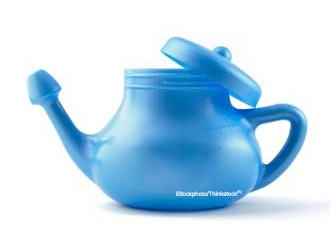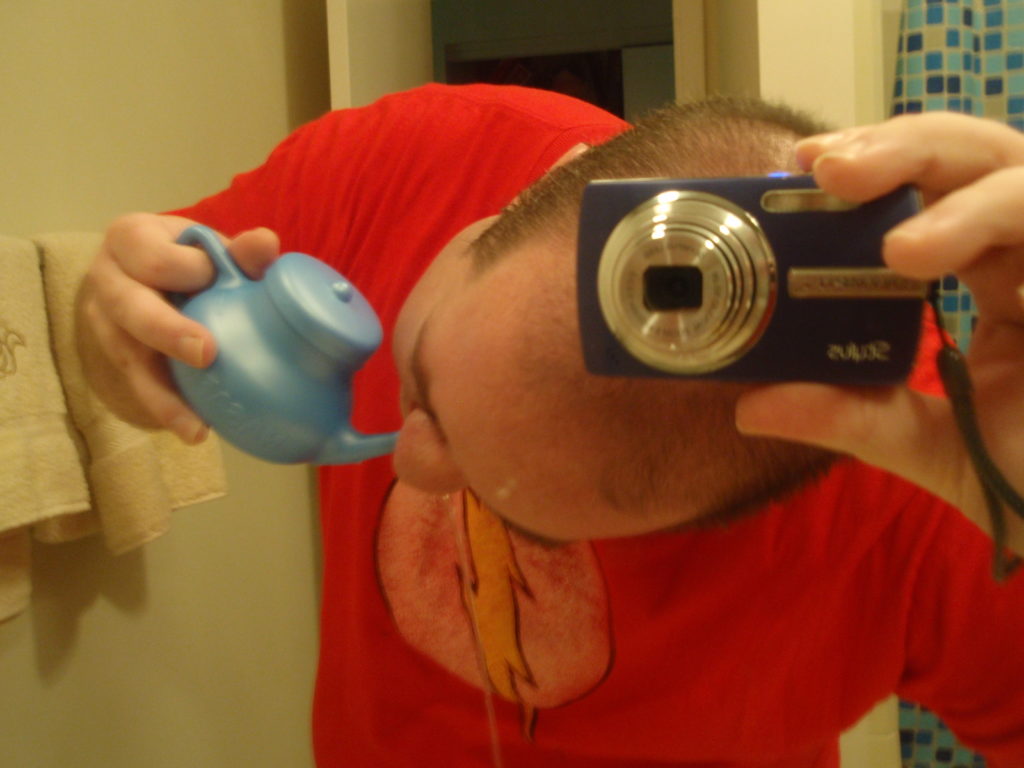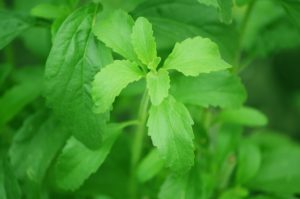Neti Pots for Allergies and Sinus Infections

Neti pots are a treatment that originally comes from Ayurvedic medicine. Ayurveda is a style of medicine that has been practiced in India for thousands of years. A neti pot is typically a somewhat shallow pot with a long spout. For use, the pot is filled with sterile salt water. This solution is then poured through each nostril while the individual leans forward. When things work as planned, the water runs in one nostril and drains out the other. In some cases, water can also run down the back of the throat into the mouth, although by adjusting your head you can usually get it to drain properly out of the nose.
Neti pots are one way of performing nasal irrigation. Other approaches include syringe applicators and spray bottles. When recommending neti pots to patients, I often get strange responses. Some people don’t like the idea of running water through their sinuses. Others have tried, but struggled to get it to work right. It’s also not unusual that people have unrealistic expectations about how they work and what they should expect.
Nasal Irrigation
The basic idea of nasal irrigation is to use salt water to rinse out irritants, which can include bacteria, allergens or other dirt and debris that are contributing to symptoms. There’s also some discussion that regular nasal irrigation might strengthen the tissues to become more resilient to irritants and promote better clearance.
The treatment can be applied to most nasal and sinus problems, including hay fever and nasal allergies and acute or chronic sinus infections. Research into nasal irrigation is ongoing, but so far, shows positive results and improvements in symptoms.
Nasal Irrigation and Allergies
Seasonal allergies can make people miserable. Having a runny nose during peak pollen season is uncomfortable at best. While more robust data is needed, the latest review of evidence for nasal irrigation as a treatment for seasonal allergies shows benefits in children and adults. Compared to nasal steroids, nasal irrigation appeared to provide similar relief (Head 2018). Side effects of nasal irrigation were minimal.
Research has also explored whether different concentrations of salt water may improve results. While for allergies, the data is less robust, there is some indication that higher concentrations of salt may improve the benefits (Marchisio 2010). However, more concentrated solutions can also lead to discomfort during treatment, including stinging or burning sensations.
Nasal Irrigation and Chronic Sinus Infections
Chronic sinus infections can cause significant pain, pressure, headaches and nasal discharge. And like allergies, the published data appears to suggest that nasal irrigation is also effective at reducing symptoms and improving outcomes. For chronic sinusitis, research also more strongly suggests that higher concentrations of salt (hypertonic saline) work better for symptom reduction than less concentrated formulas (Liu 2020).
How to Use a Neti Pot
There are a couple of key points for using a neti pot. First, there’s nothing magical about the design of a neti pot. You can use a kitchen measuring cup with a spout or even a paper cup if you fold the top to make it easier to pour into your nostril.
The water used needs to be sterile! This is important. There is a rare parasite that is occasionally found in tap water that can penetrate the sinuses and get into the brain. It is usually fatal (Siddiqui 2016). You can avoid any risks for this parasite by using distilled water or boiling your tap water beforehand.
How to Make Saline for Use
The water should be body temperature. And don’t use plain water without salt! If you ever make this mistake, you will know very quickly. Plain water really irritates the sinus passageways with intense burning or stinging sensations. Pharmacies sell salt packets to make up saline, but you can make your own with table salt. Normal saline is 9 grams of salt in 1000 mL of water. This works out to about ½ tsp of salt per 1 cup of water for a non-stinging nasal rinse solution.
To make the potentially more effective concentrated solution, you can increase the salt to 1.5 tsp per 1 cup of water. Keep in mind that this hypertonic solution will cause some irritation. Also make sure the salt is completely dissolved before use, otherwise the last bit will be super concentrated and really hurt.

Generally, neti pots or nasal irrigation is utilized twice daily when needed. Some people find it easier to do in the shower, since the procedure can be a bit messy. To perform nasal irrigation, you can lean your head forward tilted to one side at about a forty-five degree angle. Next you insert the spout of the neti pot in the elevated nostril and start to pour. If you pour too quickly, most of the water will spill. Done slowly, the water runs into the top nostril and drains out of the bottom nostril into the sink. There are plenty of videos on youtube that also demonstrate the procedure.
Conclusion
Nasal irrigation and neti pots have become an accepted approach for effectively reducing nasal and sinus symptoms. If you suffer from seasonal allergies or chronic sinus infections, using a nasal irrigation technique, like a neti pot, can help.



